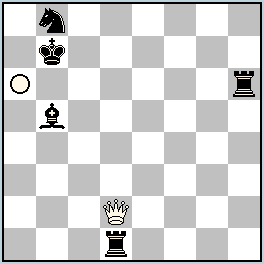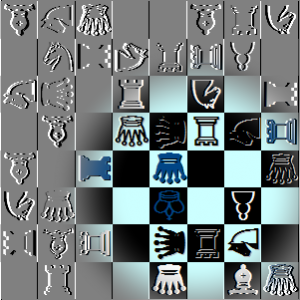|
|
Original Problems (page 122)Original fairy problems published during 2012 will participate in the informal tourney JF-2012. The site is mostly about fairies, but h# and s# are also welcomed for publication! Please send your problems to my e-mail: julia@juliasfairies.com Go to →List of Problems ; →Page 121 ; →Page 123 |
No.187 – Ser- #6 by Peter Harris – A Series-direct problem with interesting and difficult solution! (JV)
Definitions:
Sentinelles: When a piece (Pawn excluded) leaves a square outside the first and last rows, it leaves a Pawn of the color of the side that played unless 8 Pawns in this color are already on the board.
Anti-Circe (Cheylan): As antiCirce Calvet except that captures on the rebirth square are not allowed.
Super-Circe: When captured, a piece is reborn on any free field on the chess board without causing self-check or selfmate. Possible is also removal of captured piece from the board. The Pawns (white, black, neutrals, half- neutrals) can be reborn on the first or eight row also. When reborn on the first row (for Black) or on the eight row (for White) the promotion is obligatory. When reborn on the first row (for White) or on the eight row (for Black) the Pawns are immovable.
Orphan (O): An orphan can move only when observed by an enemy piece; when so observed it can move like the piece(s).
|
No.187 Peter Harris
South Africa
original-17.12.2012
 Ser- #6 (2+5)
Sentinelles Anti-Circe (Cheylan) Super-Circe Orphan a6 Solution: (click to show/hide)
|
The diagrams are made on WinChloe and its Echecs font is used for Logo design



C+ (by Popeye) With my PC in ~ 7 min.
bRh6 is there only to prevent a cook: 1.Qd2-d7[+wPd2] ? 2.Qd7-c7[+wPd7] 3.d7-d8=R 4.Rd8-c8 5.Qc7-b6[+wPc7] 6.c7*b8=S [+bSe8][wSb8->g1] + Rh6xQb6 [+bPh6] [wQb8] [bRh8]!
This cook could be better removed with a white Kg7:
White Kg7 Oa6 Qd2
Black Sb8 Kb7 Bb5 Rd1
Unchanged intention.
I was aware of the possibility of having a wK instead of the bR to prevent a cook.
I chose the bR for three reasons:
this is a direct mate problem not a helpmate and so [generally] if a piece has to be added I prefer to add a Black rather than a White piece – even more so in a series direct mate where Black does not move at all.
In this particular problem I liked the fact that the bR observes the wO giving W the possibility at some stage of moving the O as a R
and I placed the bR on h6 and not elsewhere, so that it observed h1 and perhaps could capture a wRh1.
All the foregoing is to give W [the solver] more to think about – both from his offensive capability and from B’s defensive capability.
The bR breathes more life into the problem.
I appreciate your interest Paul.
>this is a direct mate problem
Yes by convention this type of problem is called series direct mate, but is it really about threats, defences, zugzwangs? What is so direct about ser-# where the “opposing” side is idle (there’s no opposing) from the solvers point of view? 🙂
And i have always thought that preference for choosing the color of technical piece to be added depends on the economy of mating position (model mates etc) : if you mate the bK you should prefer adding black pieces, no matter #n or h#n, if you mate the wK (s#n) it is the black pieces to be preferred (in general).
typo:
If you mate the wK (s#n) it is the white pieces to be preferred (in general).
I can’t understand such logic for s#, White must force Black to mate and Black defends against it. This fight between W and B is interesting if W has minimum of necessary material, just as in #n. It’s generally easy to force a selfmate in a chessgame when W has great material advantage.
Helpselfmate requires a minimum of both W&B necessary material, but I still care first about W material because there is s#1 in the end. Superfluous white force in hs# seems to be tolerated recently. It looks like “Why to bother with other genres and struggle for the economy, when it’s so easy in a helpselfmate”.
I’m not an expert at all, but they praise model mates in s# awards and frown upon black pawns that do not participate in mating positions in longer (single-line?) selfmates, don’t they?
I’m not an expert too, but general logic principles are more important to me than personal opinions of so called “experts”. Of course, the economy of W&B pieces depends on the thematic content. Rex solus or black minimal can be interesting in #n if there are interesting tries. But generally, the fight between too strong White and too weak Black doesn’t look very interesting.
In a long single-line selfmates Black defends only in tries, in the solution he does not defend but usually plays the only legal moves. It is a kind of choreography where White must carefully lead a dance. It certainly could be beautiful and the specially adjusted principles of economy are natural for such problems. But they should not be considered as the general principles for s#.
Everything is relative 🙂
Yeah, but don’t you show that such logical reasoning can not be applied in this case? It is often unlikeness to the general case what makes position a problem, and you can achieve this unlikeness in many ways.
Rex solus directmates can be aesthetically pleasing because despite having total material advantage the solution may be very subtle and quiet (unlike OTB/general case where it is rude and forced).
White minimal directmates can be aesthetically pleasing because despite having total material disadvantage white still can reach the aim (unlike OTB/general case).
————–
Therefore material economy principles can not be deducted from what happens in the general case of material advantage/disadvantage alone (they require some other considerations).
Yes Dmitri, that’s more or less what I think. But people incline to take some special principle as a dogma, so I reacted to your correction:
>>typo:
If you mate the wK (s#n) it is the white pieces to be preferred (in general).<<
White material should be the starting point in general, considering the economy, but only as a flexible approach, not as a dogma.